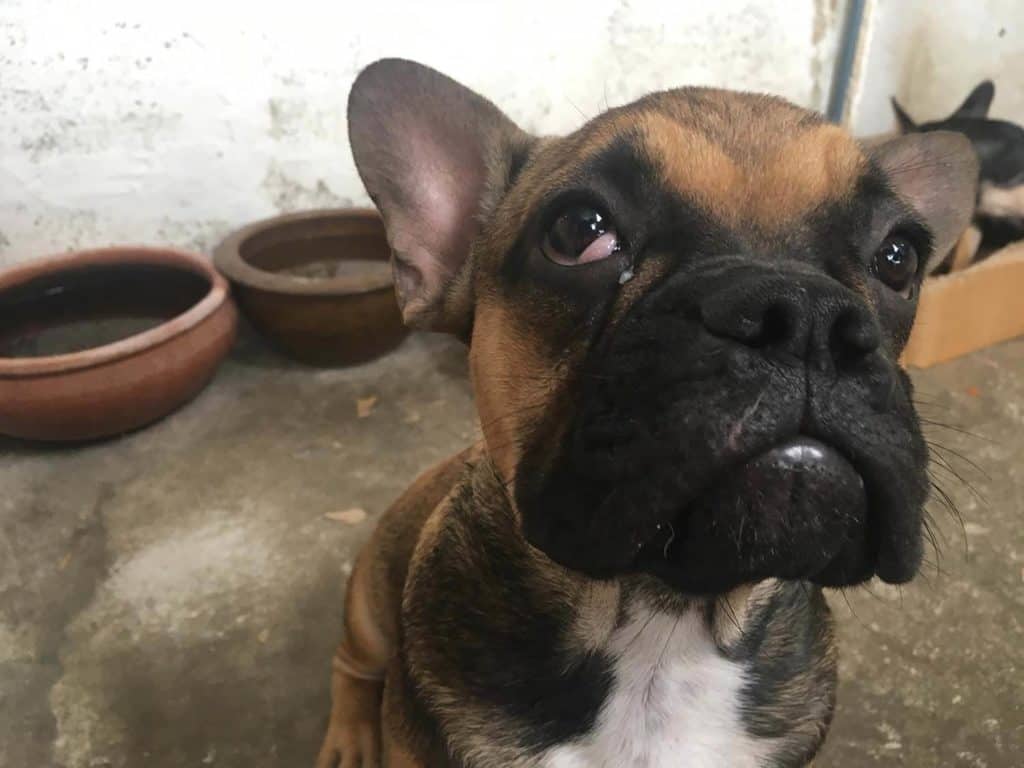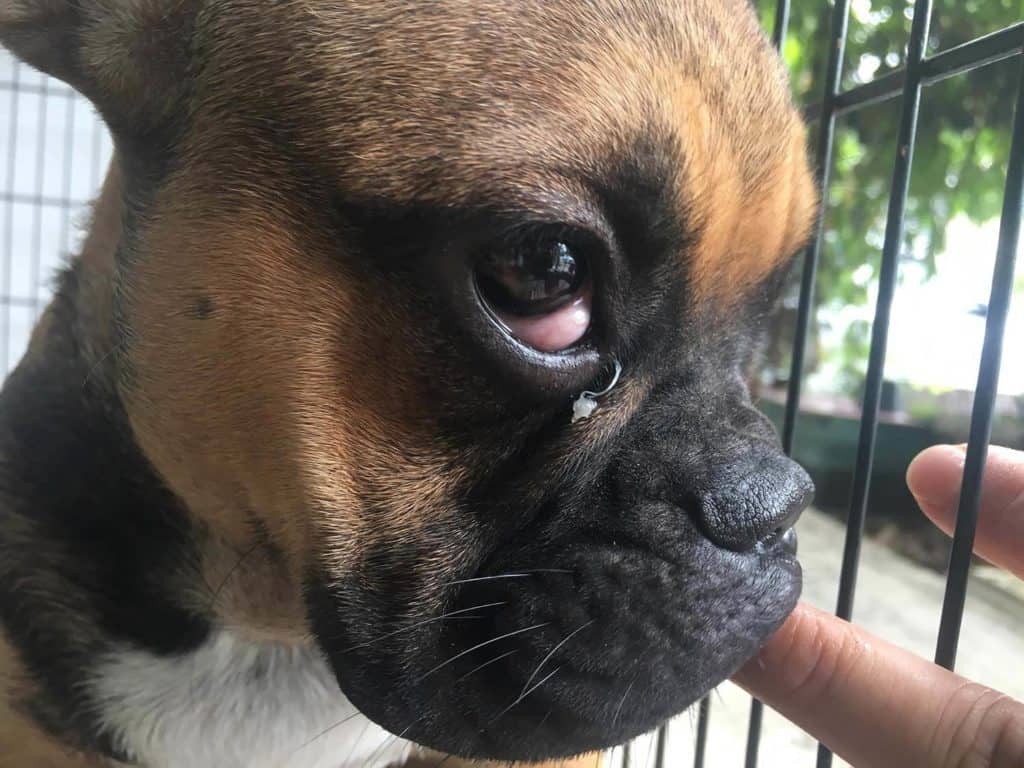
If you’re a proud, loving Frenchie parent, one of the common issues that you should learn about is Cherry Eye, including what it is, what you should know about it, and how to treat it!
Cherry Eye is a prolapse on your French Bulldog’s third eyelid, the nictitating membrane. This gland is responsible for tear production and a little extra protection. When the condition occurs, the corner of your Frenchie’s eye pops out and turns red. Cherry Eye is a common breed-specific issue with French Bulldogs.
What are the causes for French Bulldog Cherry Eye?
Most researchers will be quick to say that they can’t agree on one sole source for Cherry Eye. Triggers for it can include injury to the eye and eye area or infection such as Pink Eye. However, these are seen as triggers rather than actual causes.
The most assumed cause of Cherry Eye in French Bulldogs is genetics. In general, most French Bulldogs are naturally prone to Cherry Eye, with big and protruding eyes, and those puppies with parents who have it can develop Cherry Eye. It’s thought the cause may be partially due to the compacted form of their skull.
Is Cherry Eye hereditary in French Bulldogs?
Cherry Eyes aren’t always inherited, but it is quite commonly a factor, yes. Parents who have Cherry Eyes are much more likely to have puppies that will deal with it too. Frenchie’s eyes, as younger dogs, will have a prolapse between the age of 2 months and approximately 3 years. It’s considered rare for a French Bulldog to have a Cherry Eye beyond age 3, but not totally impossible!
Does Cherry Eye hurt?
While it isn’t the worst pain in the world, a Cherry Eye can be painful for your dog, yes, especially since it will often feel worse for him when you try to treat Cherry Eye (more on that later). When you take a look at the symptoms, you’ll see why it is so important to give proper care to your Frenchie’s eyes when this happens.
French Bulldog Cherry Eye symptoms
The good news with Cherry Eye (like Pink Eye in humans) is that it’s pretty easy to diagnose because its symptoms are unmistakable! Common ones for the responsible pet parent to look for include:
- Swollen red mass in the corner of the eye
- Excessive tear production
- Squinting
- Dry eyes
- Rubbing or scratching
Quite often, these symptoms will come on pretty quickly. As soon as you start noticing that your dog is scratching at his eye more than usual, you may see the prolapse swelling up, too. For many, it’ll feel like it came out of nowhere!
Is Cherry Eye contagious?
We mentioned pink eye above as far as a comparison. Still, you’ll be happy to learn that Cherry Eye is not contagious from dog to human or from dog to dog! If you notice that our dog has a case of it, you’ll want to let your breeder know, as they often will use that to help refine their breeding in the future.
Should I call the vet?
As soon as you notice a Cherry Eye developing in your dog, you’ll definitely want to contact your vet to get him in. Cherry Eye does require some kind of treatment (more on that in the next section), and it can quickly worsen from a mild case to a moderate or severe one.
How do you get rid of Cherry Eye in a French Bulldog?
Since Cherry Eye is a relatively common problem with French Bulldogs and other breeds, there are quite a few treatments that exist for a dog dealing with. In order of “complexity”, these include:

- Anti-inflammatory eye drops
- Antibiotic drops
- Massage
- Surgery
The non-surgical treatment of Cherry Eye is always the first step, as the Cherry Eye surgery is reserved for the most severe, recurring cases.
Anti-inflammatory eye drops
This is usually the first “point of attack” that a vet will recommend. These dog safe eye drops will help reduce the swelling of the prolapse itself. It also has the added benefit of reducing quite a lot of the symptoms.
In mild cases, just the proper course of treatment for the drops will help reduce it, more or less, helping the gland back to its normal position. This isn’t the way to actually cure Cherry Eye, but it will help your Frenchie get back to his normal self.
Antibiotic drops
Sometimes these are used at the same time as the anti-inflammatory drops in mild cases. In mild to moderate cases, where the prolapse is pronounced, it’s common to have both antibiotics and anti-inflammatory drops together. This is to help make sure that your dog’s eye heals properly without putting him at risk of getting an infection at the same time.
Massage
In moderate cases, careful, trained massage therapy can be helpful, too. Your vet will be able to walk you through gentle massage therapy around the Cherry Eye to help ease discomfort for your dog. This will encourage the gland to go back to its place in the corner of the eye.
The method is often combined with dog safe eye drops. Remember never to perform massage therapy on your dog unless it’s been prescribed by your vet and you know how to do it. Doing it incorrectly can worsen the condition!
Surgery
There are main types of Cherry Eye surgery that can be performed by experienced and adequately trained vet surgeons. Their recommendation is based on how bad a case is and the health and general well-being of the dog. There are other factors that will help note what will give him the best positive outcome.
Stitching the gland to its place
This is the surgery with the fastest recovery time. The surgeon will use permanent stitching to attach the gland to its wall in the corner of your Frenchie’s eye. This is going to help it stay where it should be and will also help reduce inflammation.
Creating a new pocket for the gland
A surgeon will create a brand new pocket for the gland when the stitching isn’t recommended. This will enable the proper placing of your dog’s gland back in its rightful place.
Total removal of the third eyelid
In especially severe cases, the surgeon may recommend total removal of the third eyelid gland. Total removal is the only way for a Frenchie to be completely free from Cherry Eye forever. In cases where Cherry Eye occurs again and again, and/or in both of the dog’s eyes, a surgeon can recommend this to improve your French Bulldog’s quality of life.
As you can see, the more severe the case, the more intense the recovery is going to be for your dog. This is why early detection is so important! It helps to tackle the problem when it’s as small and as simple as possible.
How much does it cost for surgery?
The final price will depend on the surgeon and what the actual procedure is that he recommends. Still, you can expect to pay around $800 for surgery on a Cherry Eye. This would be per eye, too, if you are looking at getting both done.
What happens if Cherry Eye is left untreated?
You might be tempted to skip the vet visit if you notice a mild case of Cherry Eye in your dog. It’ll go away on its own just like a typical irritation, right? Wrong, actually. A prolapse isn’t just a mild irritation or redness. It’s a detached eyelid, between the upper and lower lid, in the corner of the eye, that is now causing a lot of problems to your dog’s eye. The longer you leave it, the more severe it will come.
If you leave it too long or refuse treating Cherry Eye, you’ll be compromising his comfort. As mentioned, Cherry Eye can be very painful for your dog, and it’s hard for him to understand how scratching at it doesn’t make it any better.
Equally as important, ignoring this condition can create long-term problems with his health; for instance, a permanent dry eye, to the point of being chronic and severe as a common side effect. After all, the point of the third eyelid, or nictitating membrane, is to lubricate the eye so the dog doesn’t have dry eyes. Infections are also more common, as the tear production by the tear gland will help remove contaminants from the eye.
In some cases, if left untreated, Frenchie’s Cherry Eye can even impact a dog’s vision permanently. Cherry Eye is never something to be ignored when it comes to the longevity and safety of your dog!

How to prevent French Bulldog Cherry Eye?
As we’ve said, experts aren’t entirely sure on the formal cause of Cherry Eye, so there is no certain way to guarantee that your puppy won’t end up dealing with it. However, there are many things you can do to help keep him as protected as possible.
Firstly, if you are bringing your French Bulldog home from a breeder, do your research! Your breeder should be able to tell you information about your puppy’s parents, including a possibility of Cherry Eye and other concerns. While a family history free from Cherry Eye doesn’t guarantee that your Frenchie won’t struggle with it, it does help reduce its likelihood!
The second thing you can do to help your dog stay as safe as possible is to keep the eye in as good health as possible. Check it regularly for even the faintest signs of a problem, and don’t be shy in asking your vet to prescribe some sort of daily eye drop for your dog if you really want to stay on top of it.
Again, there’s no way to guarantee that your dog will never struggle with Cherry Eye. Still, focusing on these types of preventative measures will definitely put the odds in his (and your) favor!
A common health concern in Frenchies, understanding what Cherry Eye looks like and how to treat it will get you and your dog back to normal as quickly as possible!
All things considered
French Bulldog Cherry Eye develops when one of the three eyelids of a dog, the third eyelid which is also called the nictitating membrane, separates from its rightful spot and Cherry Eye appears in the eye itself as a swollen tear gland. More tear production becomes visible as well. Drops and surgery can sometimes be treatment options.
Know someone with a French Bulldog who would find this information really helpful? Share this with them and help do your part!
